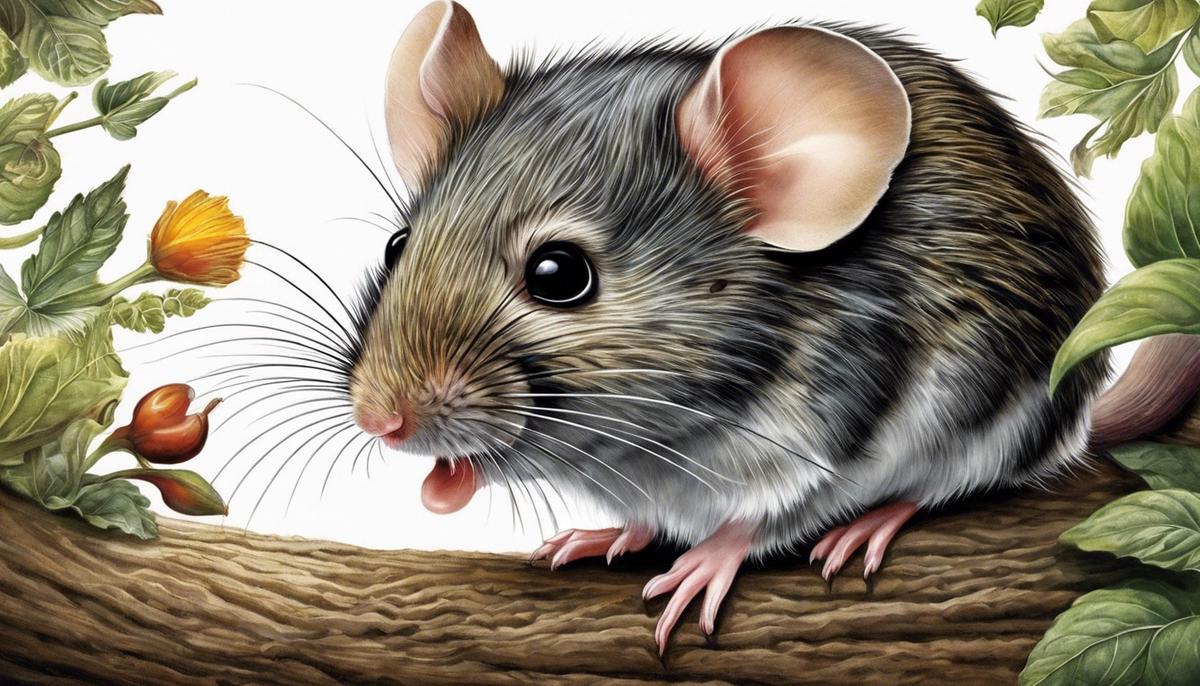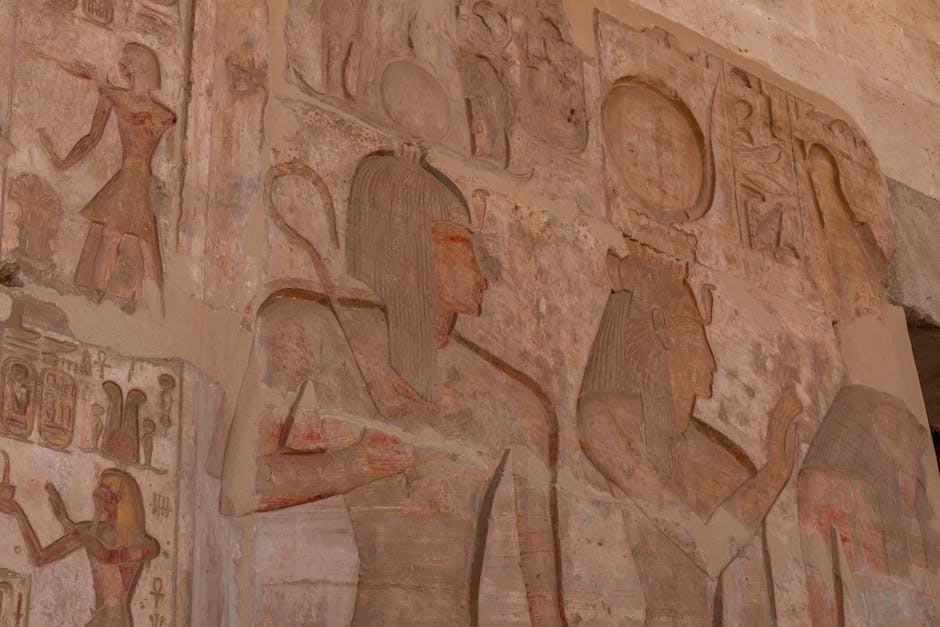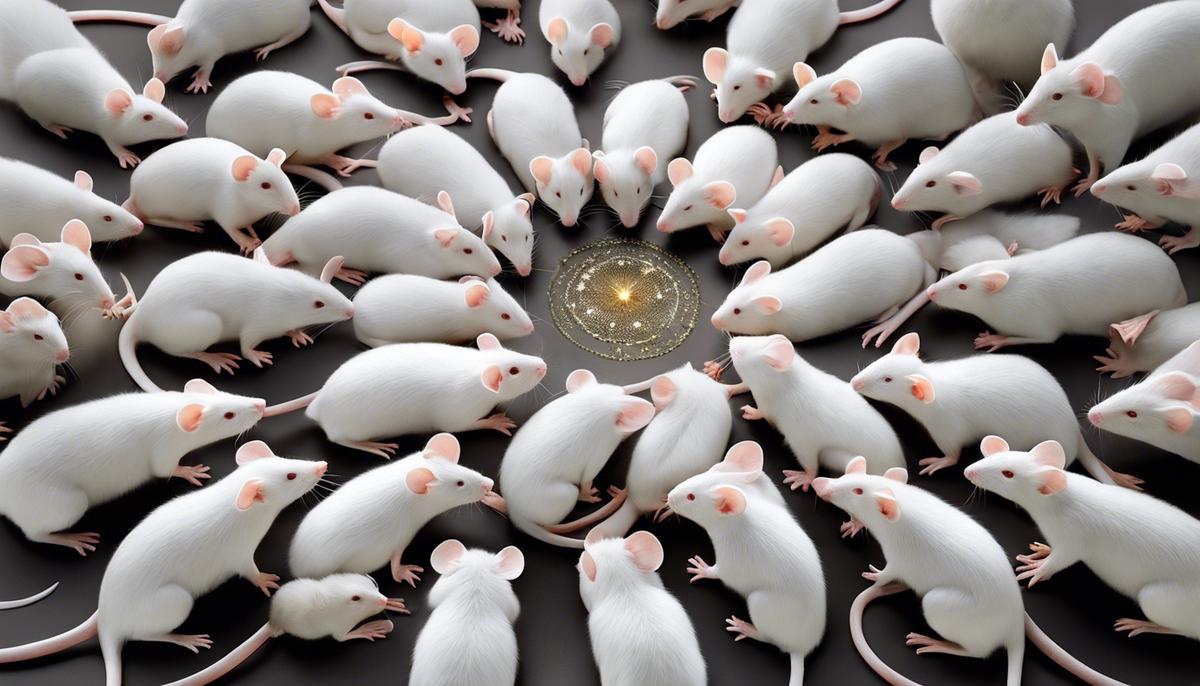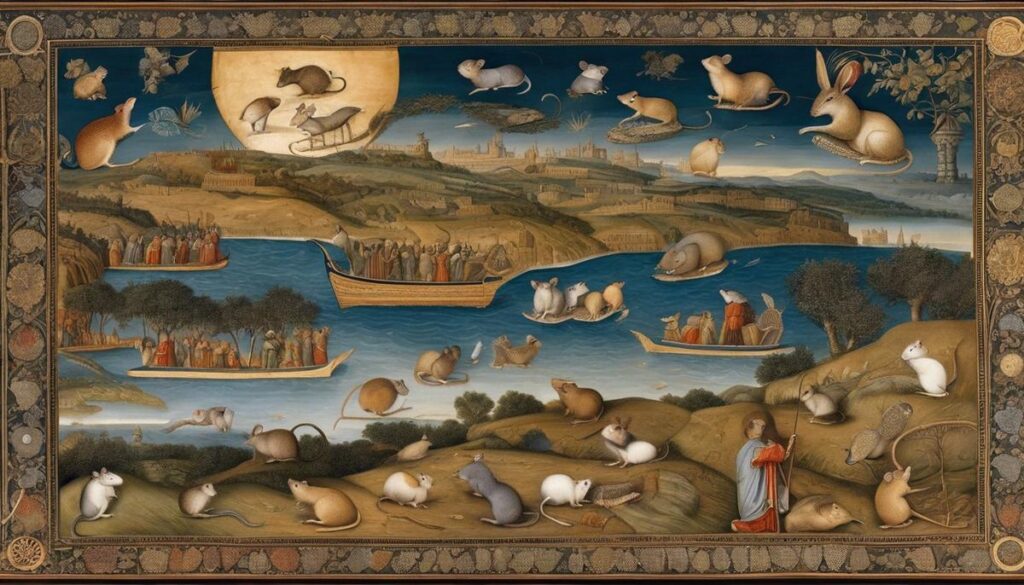Across sacred texts, dreams come laden with metaphoric significance and offer divine insight. One such recurring imagery throughout religion and mythology is the vision of the humble mouse, often overlooked in its real-life, day-to-day encounters. More so, when its coat is of an undistinguished white. This essay embarks on a journey into the multi-layered meanings of white mice in dreams, as understood in the Christian tradition. It canvasses the biblical symbolism of mice and the color white mainlined through dream interpretation methodologies within the Bible.
Biblical Symbolism of Mice
While seemingly minuscule in the grand panorama of biblical narratives, the humble mouse stands as an unexpected, albeit important, symbol in these sacred texts. This small, seemingly insignificant creature yields profound implications for understanding ancient religious cultures and moral teachings.
At first glance, one finds a straightforward portrayal of mice in the Bible – they are unclean creatures. Under Levitical laws, as captured in Leviticus 11:29, they were among creatures that constituted the echelon of forbidden food. Seen through the lens of sacred dietary laws, they carried a stigma that resonated through the ancient Israelite community. This perspective, anchored in the themes of purity and impurity, was not exclusive to Israelites but was also echoed in neighboring cultures, a testament to the pervasive and enduring attention the mouse received.
Unearthed from biblical texts is another capacity in which mice are viewed: pestilence. For instance, in the I Samuel 6 narrative, mice are associated with a wave of destruction – the plague that beset the Philistines. One interpretation posits that this association with disease was a reflection of the practical understanding at the time that mice could indeed be carriers of diseases.
Given these interpretations, one might surmise that the representation of mice in the Bible is exclusively negative. However, to do so would oversimplify the intricate symbology at work. As testament to this complexity, scholars have drawn parallels between the ancient Egyptian deity Ra and the associated solar disc, and the “golden mice” described in I Samuel 6:4,5. Here, the mice are seen not only as agents of devastation, but also as symbols of a divine power.
Moreover, the idea of mice as destructive entities encompasses larger theological concepts. The act of destroying may often seem as malevolent, yet, it also carries the potential for spurring necessity of change and subsequent growth. This transformative aspect illustrates the intricate moral universe the Bible, and by extension the ancient Israelites, inhabited.
In conclusion, the biblical imagery associated with mice is multifaceted, spanning from perceptions of impurity to emblem of disease, even to a possible symbol of divine interaction. Yet, these interpretations do not stand in isolation. They interweave into larger, more complex threads of religious understanding, moral instruction and societal norms of the times. Unraveling the significance of a seemingly minor character such as the mouse yields fascinating insights into the rich tapestry of biblical narratives and ancient cultures.

Symbolism of White in The Bible
A Divine Palette: The Biblical Portrayal of the Color White
The interpretation of color has been a topic of great intellectual curiosity for scholars across multiple disciplines. Within the Biblical context, hues bear not just optical relevance, but a deeper symbolic significance. One such color is white, used extensively throughout both the Old and New Testaments.
White tends to be correlated with purity, innocence, and righteousness within the Bible, painting a beautiful representation in the canvas of divine storytelling. In examining the portrayal of the Book of Revelation, white forms a thematic consistency, particularly emphasizing victory and salvation. White horses signify the triumphant return of Christ, while white robes indicate redemption and the perseverance of God’s faithful (Revelation 6:2; 7:9, 13; 19:11-14).
The symbolic richness of white extends to the Exodus narrative. Upon receiving the commandments at Mount Sinai, Moses’ face was described as shining with a brilliant white light, indicating his closeness to God and reflective of divine wisdom (Exodus 34:29-30). White, in this context, illustrates a profound bond between the divine and the mortal.
Moving on to the practices of biblical times, the use of white in rituals was customary, symbolizing sanctity and purity. The High Priest’s garments during Yom Kippur, regarded as the holiest day in the Jewish calendar, were white, reinforcing the ideal of purity required for atonement (Leviticus 16:4).
The color white’s association with the divine continues into the New Testament. The transfiguration of Jesus is a key example as His clothes became ‘dazzling white’, portraying His divine nature and glory (Mark 9:2-3). Additionally, in the Book of John, Jesus refers to ‘fields that are white for harvest’ (John 4:35), as an allegory of souls ready for spiritual cultivation.
While purity, righteousness, and divinity are the most common interpretations of white, it would be an oversimplification to limit its representation. The Book of Ecclesiastes employs white to illustrate joy, as it encourages wearing ‘white garments’ and having oil on the head to signify happiness (Ecclesiastes 9:8). Here, this hue gets syncretized with pleasure and contentment, showing white’s contextual versatility.
Even subtly, white has influenced the biblical depiction of nature. The ‘white as snow’ metaphor – commonly used in biblical language – associates this color with cleanliness and transformation.
In conclusion, white forms an integral thread in the Bible’s colorful tapestry, resonating with purity, righteousness, salvation, joy, and divinity. Deeper than a mere visual detail, its multifaceted representation contributes greatly to the Bible’s narratives and their underlying themes. Nonetheless, such symbolism is not absolute, reminding us that Biblical interpretation is multifaceted, renewing, and ever-evolving, much like the vibrant shades of color it employs.

Interpreting Dreams within a Biblical Context
As we delve deeper into our exploration of symbolism within biblical context, it is essential to navigate towards understanding dreams and their interpretations, a topic steeped in layers of multi-faceted spiritual meanings.
From Genesis to Revelation, dreams occupy a pivotal place in biblical narratives. They are seen as a mysterious, yet, powerful medium of divine revelation – a thread of communication from the Divine to humankind. Strikingly, across biblical accounts, the depiction of dreams and their interpretations present an intriguing blend of the heavenly and historical, portraying both the spiritual and the sociocultural dimensions of these historical epochs.
A compelling instance is Jacob’s well-known dream at Bethel. Here, the envisioning of a ladder with its base on earth and top reaching to heaven is profoundly symbolic, intertwining earthly existence and heavenly domain. Moreover, as angels ascend and descend this ladder, the dream signals divine intervention, protection, and communication with mankind.
Likewise, in the Book of Genesis, Joseph’s dreams show a unique combination of symbolic and prophetic elements. His dreams of sheaves bowing down and stars bowing to him are replete with symbolism, foreshadowing his future ascendancy to a position of authority within Pharaoh’s court. His dreams’ actualization points to a larger theme in biblical narratives – the affirmation of God’s sovereign plan amidst human endeavors.
In a similar vein, Pharaoh’s dreams in Genesis provide profound insights. The seven fat and seven lean cows, and likewise, the seven healthy heads of grain followed by seven thin ones, were symbolic of the seven years of plenty and the seven years of famine to come. In this context, dreams are unambiguous signals of forthcoming events, placed within the dynamic of divine disclosure and human understanding.
Daniel’s dreams, recorded in the Book of Daniel, are a catalogue of complex, visionary symbolism. From hybrid beasts to the Ancient of Days, these dreams are filled with cosmological elements, directing attention towards God’s sovereign and enduring control over human history’s unfolding.
From a more comprehensive perspective, dreams within the biblical context offer a dual nature—they are both individual and universal. While they convey distinct messages to the individuals who receive them, they likewise speak to larger, universal and community-based concerns of the historical periods they occupy, projecting a sentiment of shared experiences and destinities.
In summation, dreams within the biblical context are not simply impressionistic images of the sleeping mind. These are powerful narratives, symbolic and prophetic, offering a glimpse into a world beyond immediate perception – echoing spiritual messages and revealing a divine plan that navigates history. Their interpretation involves deciphering these complex narratives, understanding their context, and grasping their significance within the larger biblical tapestry. Throughout biblical narratives, dreams have held a place of prominence and deep interest, serving as a profound medium for understanding the intricacies of divine communication.

Decoding White Mice in Biblical Dreams
Where the confluence of biblical representation of ‘mice’ and ‘white’ can seem antithetical initially, nuances appear on deeper exploration. Mice, while traditionally designated unclean creatures under the ancient ordinances, and white, holding a purifying connotation, contrasting vastly. This dissonance might make consolidation seem implausible. Yet, dreams are intricate tapestries swirling with symbolism and can hold mosaics of meanings making such conjunctions viable.
On a broader spiritual spectrum, the notion of ‘mice’ evokes themes of humility and insignificance, subverted by perceptible resilience and tenacity, characteristics that enables this creature to thrive even under hostile conditions. Concurrently, ‘white’ in biblical parlance, transcends its superficial representation as purity or cleanliness, extending also to revelation, preparedness, and victory.
A dream involving ‘white mice’ therefore calls for deeper exegesis. This distinctive symbol amalgamation implies the intersection of binary contrasts. It might suggest transformation, signaling a transition from a state considered unclean or humble (the ‘mouse’) into a mode of enlightenment, purity, or victory (the ‘white’). This could be a comforting signal, as dreams often function as personal or communal reminders of resilience and hope in times of hardship or spiritual drought.
In other instances, dreams portraying ‘white mice’ may invoke the processes of deconstruction and reconstruction – the disintegration of old ways (represented by the mice) and the emergence of spiritual revelation, renewal, enlightenment, and victory (symbolized by the color white). Here, the symbolism could indicate an impending spiritual revival, driven through profound deconstruction and reformation.
Ranging from the individual to the universal context, the implications can be plentiful. For some, this dream might serve as a personal harbinger signifying a transformative spiritual journey. Conversely, for others, this symbol could indicate broader societal or cultural transformation, from a state of spiritual desolation to a season of renewal, mirroring the dream themes evident in the narratives of Jacob, Joseph, and Pharaoh.
Ultimately, the complexity of this imagery underscores the compelling nature of dreams as channels of divine communication – a space where the seemingly paradoxical elements can intertwine to produce profound insights. Bearing witness to this, we not only delve deeper into the multilayered aspects of the biblical context but also engage in enriching dialogues about the mysterious intersection of the divine and our subconscious. These explorations grant us powerful glimpses into the transformative nature of dreams and the formidable significance of seemingly inconspicuous symbols.

As we immerse deeper into the scriptures, we recognize how the dream of a white mouse can form a palimpsest of overlapping significances, tempered by cultural and historical contexts and individual circumstances. Drawing upon preceding insights related to chaste white and mouse symbology, we uncover not only a potential warning but also a beacon of hope, an invitation to cleanse oneself, or a signal of prosperity. Thus, Christianity’s rich allegorical landscape marches forward, encapsulating even such intriguing imagery as white mice in dreams.








